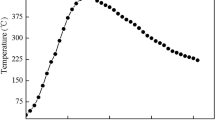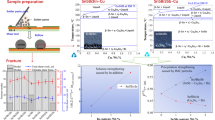Abstract
Solder paste quality can be improved from microstructure and surface status of the solder powder. In this work, the micro-morphology of solder paste was observed and the particle surface condition was analyzed. Also, the conditions of corrosion and the corrosion products in different organic acid groups (activators) were analyzed. The result shows that the SnO passive film on the solder powder surface reacts with the COO– in the active agent of the solder paste. This reaction led the passivation layer to be peeled off. It also caused the change in solder powders’ physical and chemical properties and made the metal boundary to be cold-welded. This is the root cause of solder paste exsiccation and deterioration. The study on the details shows that to obtain high-quality solder paste, one of the key methods is using the solder powder with ideal passivation shell structure and defect-free surface.









Similar content being viewed by others
References
Tummala RR, Rymaszewski EJ, Klopfenstein AG. Microelectronics Packaging Handbook. 2nd ed. New York: International Thompson; 1997. 65.
Nuty TA, Ekere NN. Monitoring the effects of storage on the rheological properties of solder paste. J Mater Sci Mater Electron. 2000;11:433.
Xu XY. Investigation on Viscosity and Stability of Lead-Free Solder Paste. Nanjing: Southeast University; 2015. 3.
Chen LC, Zhao ZH, Wang RJ. Effect of solder powder on the stability of solder paste. Rare Met. 2009;28(10):414.
Han S, Zhao MQ, Song N. Optimization on storage stability of Sn0.3Ag0.7Cu solder paste. Electron Compon Mater. 2016;35(2):60.
Yu XY, Zhao MQ, Chen XD, Yang YJ. Effect of solvent on storage stability of SnAgCu solder paste. Electron Compon Mater. 2014;33(10):63.
Jin S, Xu J, He HJ, Lu CT. Oxidation characteristics of SnAgCu lead-free solder powder. Powder Metall Ind. 2013;23(2):17.
Fouzder T, Gain AK, Chan DK. Microstructure, wetting characteristics and hardness of tin-bismuth-silver (Sn–Bi–Ag) solders on silver (Ag)-surface finished copper (Cu) substrates. J Mater Sci Mater Electron. 2017;28(22):16921.
Kotadia HR, Howes PD, Mannan SH. A review: on the development of low melting temperature Pb-free solders. Microelectron Reliab. 2014;54:1253.
Gain AK, Zhang L, Chan YC. Microstructure, elastic modulus and shear strength of alumina (Al2O3) nanoparticles-doped tin-silver-copper (Sn–Ag–Cu) solders on copper (Cu) and gold/nickel (Au/Ni)-plated Cu substrates. J Mater Sci Mater Electron. 2015;26(9):7039.
Gain AK, Chan YC. The influence of a small amount of Al and Ni nano-particles on the microstructure, kinetics and hardness of Sn–Ag–Cu solder on OSP-Cu pads. Intermetallics. 2012;29:48.
Gain AK, Chan YC, Yung WKC. Microstructure, thermal analysis and hardness of a Sn–Ag–Cu-1 wt% nano-TiO2 composite solder on flexible ball grid array substrates. Microelectron Reliab. 2011;51:975.
Gong M. Metal Corrosion Theory and Corrosion Control. Beijing: Chemical Industry Press; 2009. 711.
Landolt D. Corrosion and Surface Treatment. Swiss: Encyclopedia of Life Support Systems (EOLSS); 2016.
Landolt Dieter. Corrosion and Surface Chemistry of Metals. Swiss: EPFL Press; 2007. 15.
Xie DJ, Chan YC, Lai JKL. An experimental approach to pore-free reflow soldering. IEEE Trans Compon Packag Manuf Technol. 1996;19(1):148.
Tian Y, Chan YC, Lai JK, Pak ST. The effect of solder paste viscosity on porosity and mechanical properties of surface mount solder joints. IEEE Trans Compon Packag Manuf Technol Part B. 1997;20(2):146.
Rabiatull S, Idris A, Zuleikha S, Malek ZAA. Wettability study of lead free solder paste and its effect towards multiple reflow. In: The 3rd International Conference on Mechanical Engineering Research (ICMER 2015). Malaysia: Kuantan; 2016. 38.
Baduch Dosten, Minogur Gerad. Fundamentals of Solder Paste Technology. Glob SMT Packag. 2007;12:14.
Turbini LJ, Smith BA, Brokaw J, Williams J, Gamalski J. The effect of solder paste residues on RF signal integrity. J Electron Mater. 2000;29(10):1164.
Tuominen A, Nummenpaa P, Liukkonen T. The effect of lead-free solder paste on component placement accuracy and self-alignment during reflow. Solder Surf Mt Technol. 2004;16(1):44.
Song F, Lee SWR. Corrosion of Sn–Ag–Cu lead-free solders and the corresponding effects on board level solder joint reliability. In: Electronic Components and Technology Conference. Nice; 2006. 891.
Mori M, Miura K, Sasaki T, Ohtsuka T. Corrosion of tin alloys in sulfuric and nitric acids. Corros Sci. 2002;44:887.
Du B, Lu YP, Lei YP, Yang YL, Yang HM. Study of a new flux for SnAgCu solder paste with low silver content. Vac Electron. 2011;4:27.
Iwasaki T, Kim JH, Mizuhashi S, Munetake S. Encapsulation of Lead-free Sn/Zn/Bi solder alloy particles by coating with wax powder for improving oxidation resistance. J Electron Mater. 2005;34(5):647.
Bai R, Zhao MQ, Fan H. Study on ethylene glycol ether free flux and solder paste. Electron Process Technol. 2012;33(2):71.
Hwang JS. Solder Paste in Electronics Packaging: Technology and Applications in Surface Mount, Hybrid Circuits, and Component Assembly. Germany: Springer; 1988. 283.
Yang XY, Al-Duri B. Kinetic modeling of liquid-phase adsorption of reactive dyes on activated carbon. J Colloid Interface Sci. 2005;28(7):25.
Zhou YX, Lei YP, Li K, Wang Y. Technic adaptability of lead-free solder paste. Electron Process Technol. 2009;30(4):37.
Huang HZ, Wei XQ, Tan DQ, Zhou L. Effects of phosphorus addition on the properties of Sn–9Zn lead-free solder alloy. Int J Miner Metall Mater. 2013;20(6):563.
Mhd Noor EE, Ogundipe AS. Effect of fluxes on Sn–Zn–Bi solder alloys on copper substrate. Solder Surf Mt Technol. 2017;5(14):12.
Amalu EH, Lau WK, Ekere NN. A study of SnAgCu solder paste transfer efficiency and effects of optimal reflow profile on solder deposits. Microelectron Eng. 2011;88(7):1610.
Yu CY, Wang KJ, Duh JG. Interfacial reaction of Sn and Cu–xZn substrates after reflow and thermal aging. J Electron Mater. 2010;39(2):230.
Hu CS, Wang FH, Wu W. Review of progress in thermal barrier coating. Corros Sci Prot Technol. 2000;12(3):160.
Kim SH, Choi Y, Kim YS, Paik KW. Effect of flux activators on the solder wettability of solder anisotropic conductive films. IEEE Trans Compon Packag Manuf Technol. 2015;5(1):3.
Qin JH, Liu BQ, Gu LD, Li JM. Research of influencing factors on solder paste viscosity. Electron Compon Mater. 2011;30(7):40.
Xue J, Zhao MQ, Fan H, Zhan JF. Research on the solvents optimization of SnAgCu lead-free solder paste. Electron Compon Mater. 2011;30(2):36.
Berenguer R, Quijada C, Morallón E. Electrochemical characterization of SnO2 electrodes doped with Ru and Pt. Electrochim Acta. 2009;54(14):5230.
Idris SRA, Farihan N, Kahar H. Effect of flux onto intermetallic compound formation and growth. In: The 3rd International Conference on Mechanical Engineering Research (ICMER 2015). Malaysia: Kuantan; 2016. 34.
Acknowledgements
This work was financially supported by National Key R&D Program of China (No. 2017YFB0305700).
Author information
Authors and Affiliations
Corresponding author
Rights and permissions
About this article
Cite this article
Zhang, FW., He, HJ., Wang, ZG. et al. Solder paste metamorphism. Rare Met. 40, 1329–1336 (2021). https://doi.org/10.1007/s12598-019-01356-6
Received:
Revised:
Accepted:
Published:
Issue Date:
DOI: https://doi.org/10.1007/s12598-019-01356-6




